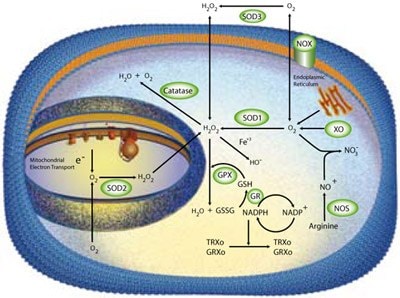Oxidative stress is implicated in the pathogenesis of lipotoxicity in both animal and human studies. Chronic oxidative stress is linked to insulin resistance in multiple tissues. Oxidative stress is mediated, in part, by reactive oxygen species produced by multiple cellular processes and controlled by cellular antioxidant mechanisms such as enzymatic scavengers or antioxidant modulators. When ROS production exceeds the cellular antioxidant capacity, oxidative damage to cellular components such as proteins, lipids, and DNA occurs. Multiple pathways can contribute to cellular ROS formation, including the mitochondrial electron transport chain (ETC), inflammatory signaling, and endoplasmic reticulum stress.
The ETC is the major source of endogenous superoxide production in the cell. As electrons pass through the ETC, a small fraction escape and prematurely react with molecular oxygen resulting in the production of superoxide. An excess of nutrients will theoretically increase electron flux through the ETC with a resulting increase in the production of superoxide. Excessive ROS production may induce insulin resistance by the activation of stress-activated signaling cascades or by causing damage to mitochondrial proteins and DNA.

Figure 1.Multiple enzymatic scavengers are utilized by the cell to limit damage from reactive oxygen species. These scavengers include members of the superoxide dismutase (SOD) family, catalase, and glutathione peroxidase.

Figure 2.Free radicals, such as reactive oxygen species, cause cellular damage via cellular "rusting".
如要继续阅读,请登录或创建帐户。
暂无帐户?